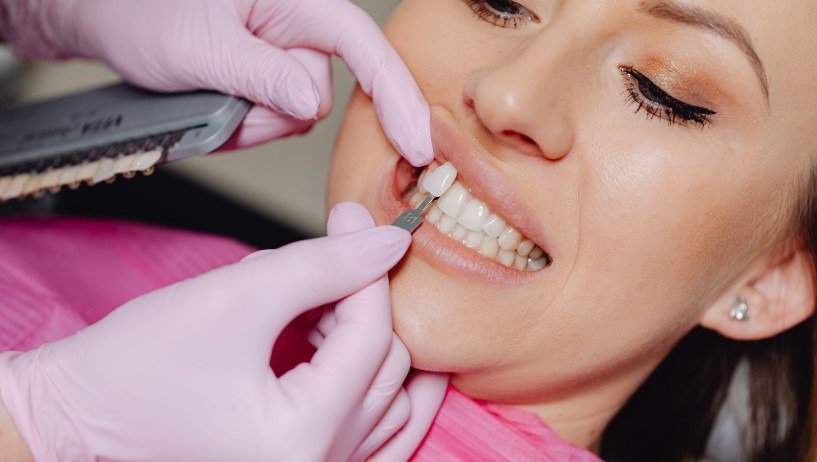When it comes to achieving a perfect smile, many people consider veneers a viable option. However, understanding whether insurance covers veneers can be a complicated task. This guide aims to break down the intricacies of dental veneers, their costs, and the nuances of insurance coverage. By the end of this article, you’ll have a clear picture of what to expect and how to navigate the insurance landscape if you’re considering veneers.
Understanding Veneers
What Are Veneers?
Veneers are thin shells of porcelain or composite resin that are custom-made to fit over the front surface of your teeth. These shells are bonded to your teeth to improve their appearance, making them a popular cosmetic dental solution. Veneers can correct a range of dental issues, such as discoloration, chipped or broken teeth, misalignment, and gaps between teeth.
- Porcelain Veneers: Known for their durability and natural appearance, porcelain veneers are stain-resistant and can last 10-15 years with proper care.
- Composite Resin Veneers: These are less expensive than porcelain veneers and can be applied in a single dental visit. However, they may not last as long and are more prone to staining.

Why Do People Get Veneers?
People choose veneers for various reasons, primarily for cosmetic enhancement and functional improvement. Here are some common reasons:
- Cosmetic Improvement: Veneers can significantly improve the aesthetics of your smile by addressing issues such as staining, discoloration, and uneven teeth.
- Damage Repair: For teeth that are chipped, cracked, or worn down, veneers provide a protective and restorative solution.
- Alignment Correction: While not a substitute for orthodontic treatment, veneers can help in minor corrections of misaligned or uneven teeth.
- Gap Closure: Veneers can close small gaps between teeth, giving a more uniform appearance.
The benefits of veneers extend beyond just aesthetics. They also contribute to improved self-confidence and overall oral health by protecting the surface of damaged teeth and reducing the risk of further wear.
Costs Associated with Veneers
Understanding the cost of veneers is crucial when considering this dental procedure. The price of veneers can vary significantly based on several factors, including the material used, the number of teeth being treated, and the dentist’s expertise.
- Average Cost Range: On average, porcelain veneers can cost between $925 to $2,500 per tooth, while composite resin veneers range from $250 to $1,500 per tooth. These prices can fluctuate based on geographical location and the dental practice’s reputation.
- Factors Affecting the Cost:
- Material: Porcelain veneers are generally more expensive than composite resin veneers due to their durability and lifelike appearance.
- Number of Teeth: The more teeth you decide to veneer, the higher the overall cost. Some patients opt for a full set of veneers, which can increase the expense significantly.
- Dentist’s Expertise: Experienced and highly skilled cosmetic dentists may charge more for their services. It’s important to choose a dentist with a proven track record of successful veneer applications.
- Geographical Location: Dental costs can vary widely depending on the region. Urban areas and places with a higher cost of living typically have higher dental procedure prices.
Cost Comparison Table: Porcelain vs. Composite Veneers
| Factor | Porcelain Veneers | Composite Resin Veneers |
|---|---|---|
| Cost per Tooth | $925 – $2,500 | $250 – $1,500 |
| Durability | 10-15 years | 5-7 years |
| Stain Resistance | Highly resistant | Prone to staining |
| Application Time | Multiple visits | Single visit possible |
Dental Insurance Basics
How Does Dental Insurance Work?
To understand if veneers are covered by insurance, it’s essential first to grasp how dental insurance operates. Dental insurance plans are designed to help cover the cost of dental care, but they often have specific rules and limitations.
- Types of Dental Insurance Plans:
- HMO (Health Maintenance Organization): These plans require you to choose a primary care dentist and get referrals for specialist care. They often have lower premiums but limited choices of providers.
- PPO (Preferred Provider Organization): PPO plans offer more flexibility in choosing dentists and do not require referrals for specialists. They typically have higher premiums and deductibles.
- Indemnity Plans: Also known as fee-for-service plans, these offer the most flexibility in choosing any dentist but come with higher out-of-pocket costs.
What Does Dental Insurance Typically Cover?
Dental insurance usually categorizes procedures into preventive, basic, and major services:
- Preventive Care: This includes routine exams, cleanings, and X-rays, typically covered at 100%.
- Basic Procedures: These encompass fillings, extractions, and root canals, often covered at 70-80%.
- Major Procedures: Crowns, bridges, dentures, and sometimes orthodontics fall under this category, with coverage ranging from 50-70%.
Understanding the distinction between cosmetic and medically necessary procedures is vital when determining coverage for veneers. Most dental insurance plans do not cover cosmetic procedures unless there is a compelling medical reason.
Insurance Coverage for Veneers
Are Veneers Covered by Insurance?
The key question on many people’s minds is whether veneers are covered by insurance. Generally, dental insurance policies do not cover veneers because they are considered a cosmetic procedure. However, there are exceptions to this rule, particularly if the veneers are deemed medically necessary.
- Cosmetic vs. Medically Necessary: Cosmetic procedures improve the appearance of teeth without addressing health issues. Medically necessary procedures, on the other hand, are required to maintain or improve dental health. For example, if veneers are used to repair a tooth damaged by trauma or decay, they might be considered medically necessary.
Cosmetic vs. Medically Necessary Procedures
Understanding the difference between cosmetic and medically necessary procedures is crucial when navigating insurance coverage.
- Cosmetic Procedures: These include treatments that enhance the appearance of your smile, such as teeth whitening, bonding, and veneers. These procedures are typically not covered by insurance because they are elective and not required for dental health.
- Medically Necessary Procedures: These are treatments essential for maintaining or improving oral health. Examples include fillings for cavities, root canals to treat infections, and crowns to restore severely damaged teeth. Insurance companies are more likely to cover these procedures.
Examples of Medically Necessary Veneers:
- Trauma Repair: If a tooth is damaged due to an accident, veneers might be required to restore its function and appearance.
- Decay Restoration: When a tooth is severely decayed, and a veneer is the best option to restore it, insurance might cover part of the cost.
- Functional Improvement: In some cases, veneers might be necessary to correct bite issues or significant structural damage that affects eating or speaking.
How to Check If Your Insurance Covers Veneers
Before proceeding with veneers, it’s important to verify your insurance coverage. Here are steps to review your policy:
- Read Your Policy Documents: Look for terms related to cosmetic dentistry, medically necessary procedures, and exclusions.
- Contact Your Insurance Provider: Speak with a representative to clarify coverage specifics and ask directly about veneers.
- Get a Pre-Treatment Estimate: Ask your dentist to submit a pre-treatment estimate to your insurance company. This will provide an official response regarding coverage and potential out-of-pocket costs.
Key Terms to Look For in Your Policy:
- Exclusions: Specific procedures not covered by your plan.
- Coverage Limitations: Annual maximum benefits and lifetime caps on certain procedures.
- Pre-Authorization Requirements: Procedures that require prior approval from your insurance company.
Tips for Getting Veneers Covered by Insurance
While it can be challenging to get insurance to cover veneers, there are strategies to improve your chances:
- Document Medical Necessity: Work with your dentist to provide detailed documentation showing that veneers are required for health reasons.
- Submit a Comprehensive Claim: Include all relevant medical records, X-rays, and photos that support the need for veneers.
- Appeal Denied Claims: If your claim is denied, don’t give up. File an appeal with additional evidence and a letter from your dentist explaining the medical necessity.
- Consult with Your Dentist: Choose a dentist who is experienced in dealing with insurance companies. They can often provide valuable insights and assistance with the claim process.

Alternatives and Financing Options
What Are the Alternatives to Veneers?
If veneers are not covered by your insurance or are too costly, several alternative treatments can help you achieve a similar aesthetic result. Here are some popular options:
- Teeth Whitening: For those with discoloration or stains, professional teeth whitening can significantly enhance the appearance of your smile. It’s less expensive than veneers and often covered under some insurance plans.
- Dental Bonding: This procedure involves applying a tooth-colored resin to repair chips, cracks, and gaps. It’s a less expensive and quicker alternative to veneers, though it may not be as durable.
- Crowns: Dental crowns cover the entire tooth, providing both aesthetic and functional benefits. They are often used for severely damaged or decayed teeth and can be covered by insurance if deemed medically necessary.
- Orthodontics: For alignment issues, braces or clear aligners can straighten teeth over time. While this option is more time-consuming, it addresses the root cause of misalignment rather than covering it up.
Comparison Table: Alternatives to Veneers
| Procedure | Average Cost per Tooth | Durability | Insurance Coverage |
|---|---|---|---|
| Teeth Whitening | $500 – $1,000 (full set) | 1-3 years | Sometimes covered |
| Dental Bonding | $300 – $600 | 5-10 years | Often covered for damage |
| Crowns | $800 – $1,500 | 10-15 years | Usually covered if necessary |
| Orthodontics | $3,000 – $7,000 (full set) | Lifetime | Often covered for under 18 |
Financing Options for Veneers
If veneers are not covered by insurance and you still want to proceed, there are several financing options available:
- Dental Payment Plans: Many dental offices offer payment plans that allow you to spread the cost of veneers over several months or years. These plans often come with low or no interest rates.
- Third-Party Financing: Companies like CareCredit specialize in healthcare financing, providing loans specifically for medical and dental procedures. These options can offer flexible repayment terms.
- Personal Loans: Obtaining a personal loan from your bank or credit union can provide the necessary funds for veneers. Interest rates and terms vary, so it’s important to shop around for the best deal.
- Credit Cards: If you have a credit card with a limit that is high enough, you could use it to pay for veneers. Be mindful of interest rates and aim to pay off the balance quickly to avoid high finance charges.
Pros and Cons of Financing Options
| Financing Option | Pros | Cons |
|---|---|---|
| Dental Payment Plans | Low/no interest, convenient | Limited to specific dental offices |
| Third-Party Financing | Flexible repayment terms | Interest rates may be higher |
| Personal Loans | Can shop for the best rates | Requires good credit |
| Credit Cards | Quick and easy access to funds | High interest rates if not paid off quickly |
Real-Life Examples and Case Studies: Do Insurance Companies Ever Cover Veneers?
While getting insurance to cover veneers is challenging, there are instances where patients have succeeded. Here are a couple of real-life examples:
- Case Study 1: Trauma Repair: Jane, a 30-year-old teacher, had her front teeth severely damaged in a car accident. Her dentist recommended veneers as the best option for restoration. By providing detailed documentation and emphasizing the functional necessity, Jane’s insurance covered 50% of the cost.
- Case Study 2: Severe Decay: John, a 45-year-old engineer, suffered from significant tooth decay due to a medical condition. His dentist argued that veneers were essential to protect his remaining tooth structure and prevent further decay. After an appeal and additional medical records, John’s insurance agreed to cover 70% of the procedure.
Testimonials and Experiences
- Patient Quote: “I never thought my insurance would cover veneers, but with my dentist’s help, we were able to demonstrate the medical necessity. It was a lengthy process, but worth it in the end.” – Sarah M.
These stories highlight the importance of persistence and thorough documentation when seeking insurance coverage for veneers.
Frequently Asked Questions About Insurance and Veneers
Can you get veneers covered by insurance for medical reasons?
Yes, it is possible to get veneers covered by insurance if they are deemed medically necessary. For instance, if veneers are required to repair teeth damaged by trauma or severe decay, insurance companies may consider covering part or all of the cost. The key is to provide comprehensive documentation from your dentist that outlines the medical necessity of the procedure.
What documentation is needed to submit an insurance claim for veneers?
Submitting a successful insurance claim for veneers requires thorough documentation. Here are the essential documents you will need:
- Detailed Treatment Plan: A comprehensive outline from your dentist detailing the procedure, including the reasons why veneers are necessary.
- Medical Records: Relevant medical records that support the claim, such as X-rays, photographs, and dental history.
- Referral Letters: If applicable, letters from other medical professionals or specialists recommending the veneers.
- Pre-Treatment Estimate: An estimate of the cost of the procedure submitted to the insurance company for pre-approval.
- Appeal Letter: If the initial claim is denied, a well-written appeal letter explaining the medical necessity and including additional evidence.
How do you appeal a denied insurance claim for veneers?
If your insurance claim for veneers is denied, you have the right to appeal the decision. Here’s how to navigate the appeal process:
- Review the Denial Letter: Carefully read the denial letter to understand the reasons for the denial.
- Gather Additional Evidence: Collect any additional documentation that supports the medical necessity of the veneers. This may include more detailed medical records, letters from other healthcare providers, and additional photographs or X-rays.
- Write an Appeal Letter: Draft a detailed appeal letter addressing the reasons for the denial and providing additional evidence.


